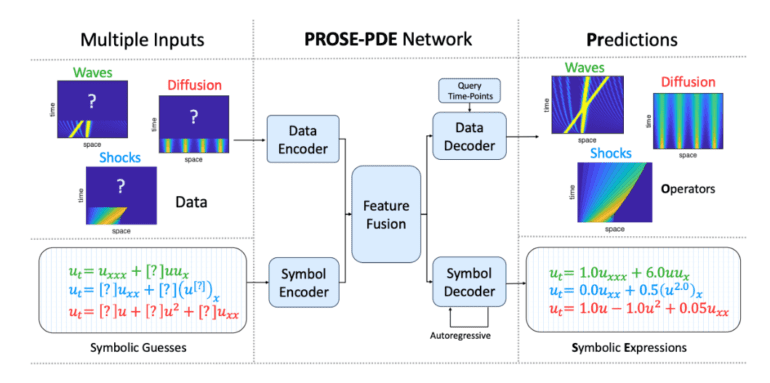- PROSE-PDE revolutionizes PDE solving via multimodal neural networks.
- Multi-Operator Learning (MOL) enables simultaneous approximation of multiple operators.
- The architecture includes Data Encoder, Symbol Encoder, Feature Fusion, Data Decoder, and Symbol Decoder components.
- PROSE-PDE excels in extrapolating physical features across diverse systems.
- The evaluation demonstrates low prediction errors (< 3.1%) and high R^2 scores across 20 PDEs.
- It paves the way for a universal foundation model capable of efficiently solving complex PDE problems and extrapolating physical insights.
Main AI News:
Delving into the intricacies of fluid dynamics, heat transfer, or natural pattern formation often involves grappling with the complexities of partial differential equations (PDEs). These mathematical constructs serve as indispensable tools across scientific realms, offering insights into spatio-temporal processes. However, their analytical solution can pose formidable challenges, necessitating computational methods or simulations. Herein lies the essence of leveraging machine learning: a paradigm shift in addressing PDE conundrums by directly approximating solutions from data.
Traditionally, numerical methods bore the brunt of solving PDEs, often entailing hefty computational costs, particularly for intricate or high-dimensional systems. Yet, the landscape has evolved. Enter neural networks, poised to bridge the gap by discerning mappings between input conditions and PDE solutions. Nevertheless, prevailing methodologies grapple with either equation-specific limitations or struggle with generalization beyond familiar terrains.
Enter PROSE-PDE, a groundbreaking multimodal neural network primed to underpin the resolution of diverse time-dependent PDEs, encompassing nonlinear diffusive, dispersive, conservation laws and wave equations. The crux of PROSE-PDE’s innovation lies in its aptitude to concurrently grasp multiple operators and extrapolate physical phenomena across disparate systems. But how does it function?
At its nucleus, PROSE-PDE embraces Multi-Operator Learning (MOL), a pioneering technique diverging from the conventional norm. At the same time, typical approaches hone in on a singular operator for a given PDE, MOL pioneers a unified model that juggles multiple operators concurrently. This is made feasible through symbolic encoding, portraying equations as trainable tokens in a Polish notation format. Consequently, the model learns to correlate these symbolic depictions with the corresponding data solutions.
The PROSE-PDE architecture comprises five pivotal components: Data Encoder, Symbol Encoder, Feature Fusion, Data Decoder, and Symbol Decoder. The Data Encoder sifts through input data sequences, while the Symbol Encoder grapples with symbolic equation conjectures. These encoded features intertwine, facilitating seamless information exchange between data and symbolic representations. Subsequently, the Data Decoder amalgamates the fused features to prognosticate output solutions, while the Symbol Decoder fine-tunes and generates the corresponding symbolic expressions.
Yet, PROSE-PDE’s pièce de résistance lies in its capacity to extrapolate physical attributes across divergent systems. Rigorous experimentation showcases its prowess in generalizing to novel model parameters, forecasting variables at future time junctures, and navigating uncharted physical domains absent from its training corpus. This remarkable attribute stems from the model’s adeptness in abstracting and transposing underlying physical laws gleaned from the training data.
Promising evaluation results underscore PROSE-PDE’s efficacy, boasting low relative prediction errors (< 3.1%) and soaring R^2 scores across a gamut of 20 PDEs. Furthermore, the model adeptly unearthed unknown equations with a trifling error margin of merely 0.549%. These findings portend a new era, heralding a universal foundation model primed for scientific applications, adept at efficaciously unraveling intricate PDE puzzles and extrapolating physical insights across heterogeneous systems.
While the current iteration hones in on one-dimensional time-dependent PDEs, the roadmap ahead envisions PROSE-PDE’s expansion into multi-dimensional and non-time-dependent equation territories. As scientific datasets burgeon, the prospects for such foundational models to metamorphose our comprehension and modeling of intricate physical phenomena are undeniably tantalizing.
Conclusion:
The emergence of PROSE-PDE signifies a paradigm shift in PDE solving, offering unprecedented capabilities in generalization and efficiency. This innovation holds immense potential for industries reliant on PDE modeling, promising enhanced accuracy and adaptability in addressing complex phenomena. As the market evolves, integrating such advanced solutions can catalyze breakthroughs in scientific research and engineering applications, driving competitiveness and innovation.

